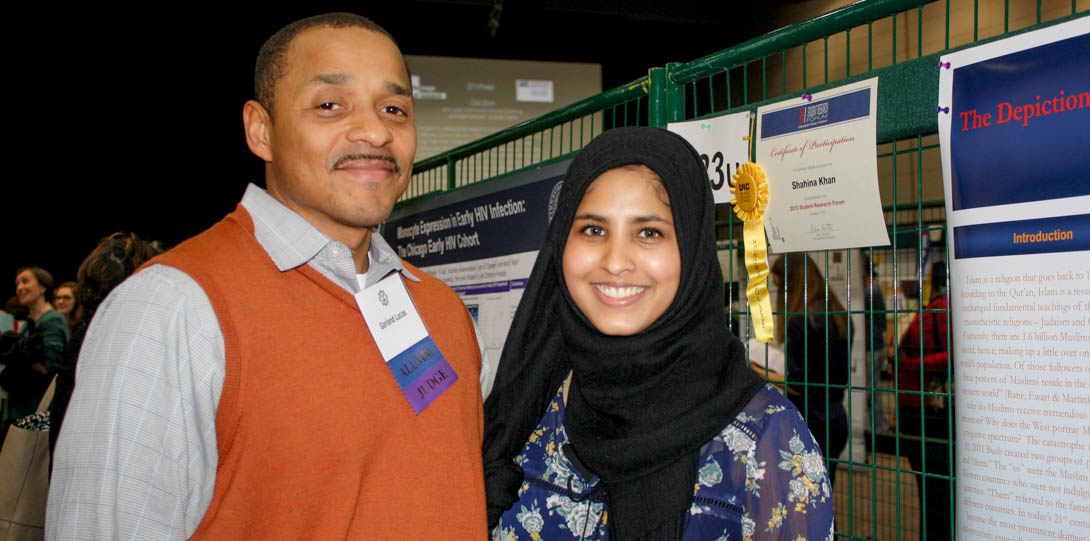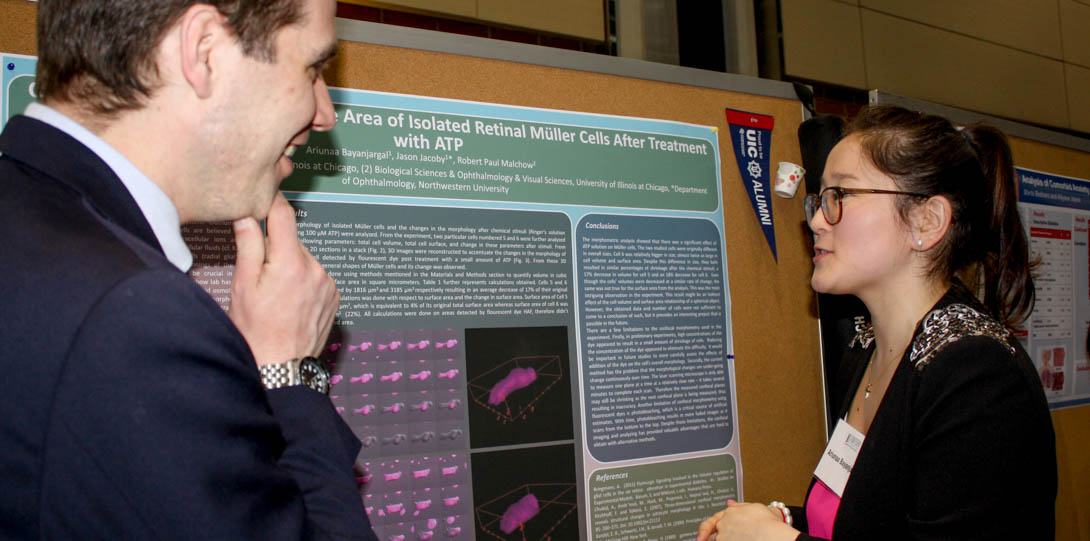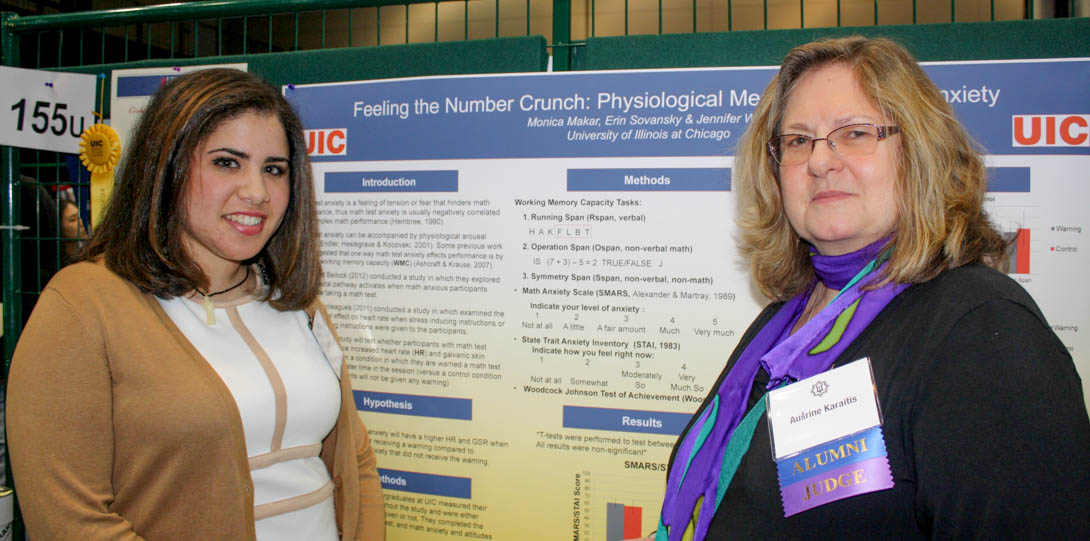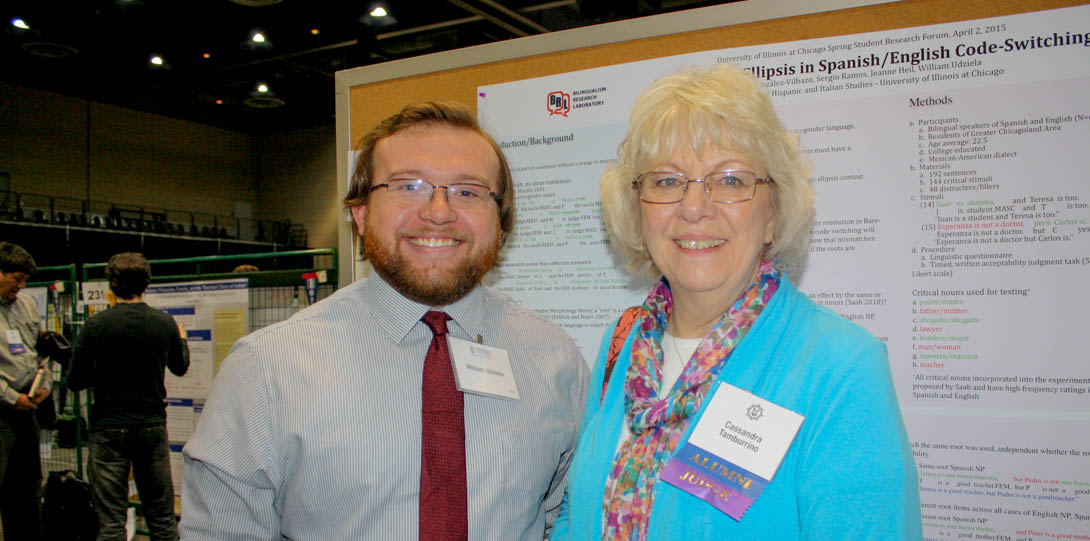Sample LASURI Abstracts
A small sample of the research projects completed by students participating in LASURI.
A small sample of the research projects completed by students participating in LASURI. All participants are required to submit an abstract at the conclusion of their project.
The Role of Language Dominance in Code-Switching Research
By Cecilia Solis Barroso (Mentor: Luis López)
This research project analyzes the role of language dominance in a Spanish-English intra-sentential code-switching production task. Here, we examine language dominance and its effect on the production of code-switched nonce verbs that are comprised of English roots and Spanish affixes (e.g. [[zert] ENGeandoSPN]) in order to determine if these words are produced with solely Spanish sounds, English sounds or a combination of both (see Stefanich & Cabrelli-Amaro, in press for rationale) . In order to determine which sound system is employed, we focus on the sound /z/, present in the English but not Spanish sound system, and its counterpart /s/, present in the English and Spanish sound systems. To measure language dominance, participants complete the Bilingual Language Profile (Birdsong, Gertken &Amengual, 2014), a widely used scalar measure that provides a dominance score from -218 to 218, by analyzing several factors that influence language dominance, such as language history, language use, and language attitude. On this continuous scale, a score of 0 to -218 is classified as Spanish dominant and 0 to 218 is classified as English dominant. The dominance scores and results of the production task are then submitted to correlation analysis in order to determine if there is an effect between the two. The results of the analysis indicate that that there is no significant correlation between language dominance and the production of /s/ and /z/, as representative of Spanish and English sound systems, in code-switched words. The results provide evidence that for these bilinguals, language dominance is not a factor in the production of code-switched words. The bilinguals all produce these code-switched words with Spanish sounds regardless of their language dominance.
Bone Dysmorphology in Sned1 Knockout Mice
By Kyleen Jan (Mentor: Dr. Christina Nicholas)
BACKGROUND: SNED1 is an extracellular matrix (ECM) protein necessary for survival and proper morphogenesis of craniofacial features by contributing materials that construct bone and cartilage. The lab generated a mouse strain in which the Sned1 gene was knocked out to better understand its role in the development and behavior of whole organism. While the majority of Sned1 knockout mice die shortly after birth, gross morphological analysis of survivors revealed craniofacial abnormalities. This project aimed to conduct morphological analyses on the mandible, long bones, and scapula of Sned1 knockout mice.
METHODS: Landmarking analysis was conducted on the mandibular structures through generalized Procrustes analysis and principal component analysis. Differences between genotypes were assessed using one-way non-parametric Kruskal-Wallis ANOVA by genotype. Long bone and scapula size were assessed by measuring the long bones antero-posteriorly and the scapulae superoinferiorly and analyzed with unpaired t-tests.
RESULTS: Sned1 knockout mice present significantly shorter mandibular condyles and smaller coronoid processes compared to wild-type and heterozygous mice (p<0.0001) along the first principal component. Long bone length was significantly shorter in knockout mice compared to wild-type and heterozygous mice (p5% right-left asymmetry in scapula length.
CONCLUSIONS: Morphological differences in Sned1 knockout mice may contribute to an early neonatal lethality rate due to inhibited abilities to breathe, eat, and move. Future extensions of this research should conduct landmarking analysis on the long bones and scapulae to further identify structural differences in morphology. This research was supported by funds from LASURI, the UIC Honors College Research Grant, and the start-up fund from the Department of Physiology and Biophysics, College of Medicine
Contextualizing Radicalization and Violent Extremism in the Somali American Community
By Abigail Floresca (Mentor: Edna Erez)
Minneapolis, Minnesota and Columbus, Ohio – home of the two largest Somali American communities in the United States – have starkly different histories of violence in their communities despite similar circumstances of immigration and settlement in the Midwestern United States. For example, while in Minnesota 2 – 3 dozen young men were recruited overseas to fight in the jihadist militia groups Al-Shabaab and ISIS and have since been incarcerated or killed overseas, it is speculated that only 1 or 2 men from Columbus have attempted to join these extremist groups. The numbers are unsure. In this research project I examine the social structures and personal perspectives of these communities through a narrative-style of criminology. Throughout the project I have explored the social-ecological factors that account for a Somali American youth’s persistence, desistance, or resistance from criminally deviant, specifically violent, behavior. Using the narratives of Somali-American youth, parents, community leaders and health providers, and law enforcement from Minneapolis and Columbus, I contextualize the terms “radicalization” and “extremism,” I examine unique perspective of a Somali young adult growing up with intersectional identities, I compare and contrast the Somali community’s establishment within Columbus vs. Minneapolis, and analyze the expressed prejudices impressed on the Somali community from American society, in order to understand what factors make Minneapolis and Columbus differ from one another. Based on available research on the topic of North American Somali Communities, I conclude that attempting to identify risk for radicalization is a dangerously ambiguous practice, and in the case of Columbus and Minneapolis, has created more harm in the community. More analysis has yet to be done. I conclude that instead, more resources must be allocated to developing and empowering this population from within in order to successfully ebb the stream of young men choosing violence as a means of achieving status and success.
A Seedy Tale: Do Grasses and Forbs Invest Differently in Seed Chemical Defenses?

By Diya Majumdar (Mentor: Dr. Chris Whelan)
Plant secondary metabolites (PSMs), found almost universally throughout the plant kingdom, function in myriad ways, including defense against enemies, attraction of pollinators, communication between plants, and protection against various abiotic stressors. Extensive research has examined how PSMs mediate interactions between plants and herbivores and plant and frugivores. In contrast, little research has investigated their potential role in defense against granivores. A number of investigators have hypothesized that grasses tend to be less chemically defended than forbs and invest more heavily in physical digestibility reducers, such as silica. To investigate the validity of this statement, we screened for six classes of PSMs in seeds of 16 native grass and 16 native forb species field collected or purchased from a native plant nursery. Standard phytochemical tests were employed to determine the presence or absence of the following PSMs: alkaloids, phenolic acids, tannins, saponins, flavanoids, and terpenes. Our findings are not consistent with the hypothesis that grasses are less chemically defended than forbs. Of the seven grasses and five forbs screened to date, grasses appear to contain as many classes of PSMs as forbs, with the possible exception of saponins. In fact, among the various PSMs screened, saponins appear to be the most underrepresented amongst both grasses and forbs. Our results, contrary to the original hypothesis, suggest that not only are PSMs common in seeds of grasses, they may play a previously unsuspected role in shaping patterns of seed selection amongst granivores.
Herbert Spencer, Use-Inheritance, and the End of Liberalism

By Matthew Beifuss (Mentor: Dr. Stephen Engelmann)
This paper explores the political-theoretical implications of the transition from Lamarckian to neo-Darwinist evolutionary paradigms at the end of the nineteenth century, particularly in imagining a post-imperial world order. Building on the work of David Weinstein and Robert Richards, we examine shifts in the voluminous oeuvre of “our great philosopher, Herbert Spencer” (Darwin, Descent of Man), especially in dialogue with J.S. Mill, Darwin, and August Weismann. Spencer’s attempt to give liberal utilitarianism a naturalist basis was deeply reliant on Lamarckian use-inheritance, and the political conclusions he drew from it were anti-imperialist, but in the context of a thoroughly imperial “civilizational” cosmopolitanism and globalism. At least in Europe, Spencer’s failure to adapt his sociology and political theory to the emerging modern synthesis doomed it to a creeping irrelevance, and ceded the scientific high ground to the racial nationalism of theorists like Rudolf Kjellen. Our point of departure is a close reading of the fascinating “Progress, Its Law and Its Cause” (1857), and we close with some reflections on the possible political implications of post-genomic critiques of neo-Darwinism in our neo-liberal context.
The Role of the Ovary in Metastasis of Fallopian Tube-Derived Cancer
By Vivian Jin (Mentor: Joanna Burdette)
High-grade serous ovarian cancer (HGSOC) is the most lethal gynecological cancer and recent evidence has shown that it originates from the fallopian tube epithelium. Tumorigenic mouse fallopian tube cells grafted into the ovarian bursa produced aggressive tumors that metastasized throughout the peritoneum, whereas the same number of tumorigenic cells injected into the peritoneal space did not cause tumor formation, demonstrating that the ovary increases aggressiveness of the disease. Factors suppressing ovulation are inversely related to the risk of HGSOC, and by mimicking the physical tearing of the ovary, we demonstrated that ovulation promotes ovarian colonization by exposing the underlying extracellular matrix. 3D collagen, a primary component of the extracellular matrix, rescued the viability of normal fallopian tube cells but not tumor cells, suggesting that pathways modified during formation of HGSOC in the fallopian tube contribute to ovarian colonization. Using mouse fallopian tube cells mutated to mimic alterations commonly observed in HGSOC, it was observed that the loss of PTEN activated AKT and RAC1/JNK signaling, which increased viability on 3D collagen, increased invasion through collagen, and increased attachment to mouse ovaries. Therefore, loss of PTEN activates multiple pathways that together enhance colonization of the ovary, a critical step in the metastasis of fallopian tube-derived high-grade serous ovarian cancer. These pathways represent novel targets to prevent colonization of the ovary and inhibit the aggressive nature of the disease in HGSOC patients.
Gender Reference in the Classroom and its Relationship with Classroom Discipline
By Qaswa Hussaini (Mentor: Kate Zinsser)
Purpose: Gender disparities in school discipline rates are well established. Recently, this concerning trend was also identified in preschool expulsion. Preschool boys are disproportionately excluded from early education settings. Although research in k-12 has documented the consequences of expulsion on children’s academic and social growth, little can be said about possible underlying causes. The present study is an initial investigation of one such precursor: preschool teachers’ perceptions of children’s gender. In an effort to better understand if teachers’ perceptions of gender influences disciplinary decisions, this study will explore three main research questions: 1) In what ways and contexts do teachers reference gender? 2) How do teachers describe differentiating behavior management strategies by gender?; 3) To what extent do teachers describe different experiences of efficacy in their interactions by gender? And 4) to what extent do these themes differ among teachers who have and have not previously requested expulsion. Procedure: This study uses qualitative interview data from a larger study of preschool expulsion from community-based preschool programs across 13 diverse Chicago neighborhoods. Teachers (N=27) were selected for follow-up interviews from the larger surveyed sample (N=126) based on representation of different neighborhood types and stratified by the number of expulsions they had requested previously. Interviews were recorded, transcribed, qualitative codes were developed and coder reliability was assessed. Coding will be completed by January 2018 and captures teachers use of male, female, and non-gendered pronouns, their positive/negative perception of children’s behavior, behavior management strategy use, and any comments pertaining to their self-perceived effectiveness in the interactions, positive/negative. Planned Analyses/Results: Using Nvivo qualitative analysis software, we will query and analyze the co-occurrence of teacher’s references to gender and positive and negative behaviors and expressions of efficacy. Qualitative matrix comparisons will be used to identify similarities and differences in these co-occurrences within and between groups of teachers who had and had not requested expulsions in the prior year. Specifically, comparison will explore gendered or non-gendered instances where teachers describe their behavioral management strategies and discuss how efficacious they do, or don’t, feel about handling the child. Implications: Teachers’ descriptions of their classroom interactions may provide insight into the underlying perceptions driving disparate discipline rates among boys and girls. Understanding teachers’ unconsciously biased perceptions of behavior and sense of efficacy in interactions with boys and girls is a critical first step towards devising interventions to reduce expulsion rates and disparities overall.
Behavioral Effects of Maternal Stress on Fragile X Knockout Offspring
By Maya Patel (Mentor: Michael Ragozzino)
Fragile X syndrome (FXS) is a genetic disorder that results in mild to moderate intellectual disability. The disorder results from mutation of the FMR1 gene that codes for the FMR1 protein, which plays a role in the development of synapses. FXS is the most common monogenic syndromic form of autism (a neurodevelopmental disorder). However, only approximately one-third of FXS individuals meet the criteria for autism. This project explores whether certain environmental conditions may interact with a FMR1 mutation to increase the risk of autism-like behaviors. Epidemiological studies suggest that pregnant women prescribed a selective serotonin reuptake inhibitor (SSRI) to treat depression may increase the risk of autism in offspring. However, it is unclear whether depression alone is a risk factor or the combination of depression with SSRI treatment may increase risk. Further unknown is how these conditions may interact with genetic factors to increase risk of autism in offspring. This experiment began to address these issues by determining how restraint stress (used to model “depression”) in FXS knockout and wild-type mice affects repetitive motor behaviors (self-grooming), anxiety and behavioral flexibility (probabilistic reversal learning) in male and female offspring. Starting on day 4 of gestation, pregnant mice were placed in a plastic restrainer for 30 minutes three times a day. This occurred through day 18 of gestation. Starting at 8 weeks of age, male and female offspring received a battery of behavioral tests (self-grooming behavior, elevated plus maze testing, spatial discrimination learning and reversal learning). The findings indicate that FXS mice experience impairments on a probabilistic learning task compared to wild-type mice. This indicates that FXS mice experience behavioral flexibility deficits compared to wild-type mice. Future studies will examine how both prenatal SSRI exposure and the combination of prenatal depression and SSRI exposure affects offspring behavior in FXS knockout mice.
Towards a computation of the limit of the F-signature of the E7 singularity
By Matthew Perlman (Mentor: Dr. Kevin Tucker)
The roots of a set of polynomial equations correspond to geometric objects called algebraic varieties, the fundamental objects of study in algebraic geometry. I study singularities of these varieties, which are points where the variety fails to be smooth. The F-signature function is a characteristic p invariant of these singularities designed to encode information related to the Hilbert-Kunz multiplicity and the F-signature, two invariants that measure singularities. In all known cases, the F-signature function of a polynomial limits to a piece-wise polynomial as p goes to infinity. However, this behavior is not well-understood and this function is notoriously difficult to compute. For example, it is not known whether the F-signature of the polynomial f=x3 xy3 limits to a piece-wise polynomial. In this paper, I will introduce algebraic varieties and the F-signature function, and then I will discuss this example, which I have computed for my capstone project.
Femininity in Military Culture

By Allyson Urista (Mentor: Dr. Kelly Quinn)
Women have increasingly taken significant roles in the military over the last 70 years. Women currently make up 15.16% of all the active duty United States Armed Forces, as opposed to 2% in 1950 (DMDC, 2014; Walker, 2012). This dramatic increase has created steady influence in U.S. military culture, particularly since the initiation of the Global War on Terror (Walker, 2012). Despite this increase, there is still a dichotomy of gender expectations within the military (Williams, 2005). Previous research in this area is thin, though it offers a modest start through the exploration of feminine perspectives within a predominantly masculine culture. For instance, dimensions of femininity have been explored, such as the relationship of femininity to leadership (Walker, 2012) and the transformation of perceptions of femininity upon entry into a collegiate ROTC program (Silva, 2008). These limited perspectives however do not address the true meaning of owning femininity in military culture. This study provides additional insight into how military culture and femininity intersect by examining data gathered through 20 unstructured interviews with women who are currently members of the US military. Major themes and concepts related to the display and constraints of feminine identity will lead to a greater understanding of female roles in military culture and the ways in which women utilize their femininity to define themselves as competent leaders and service members.



